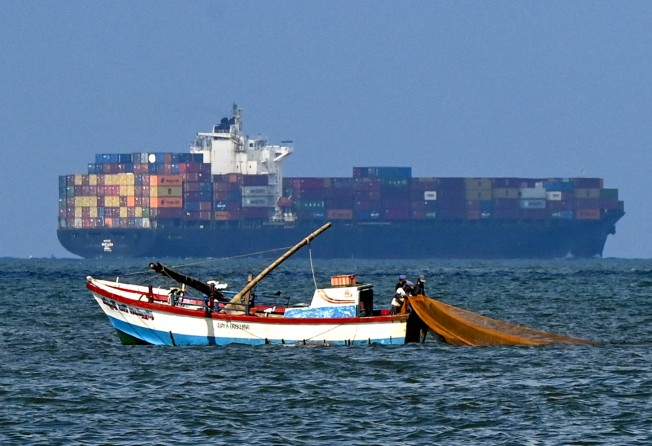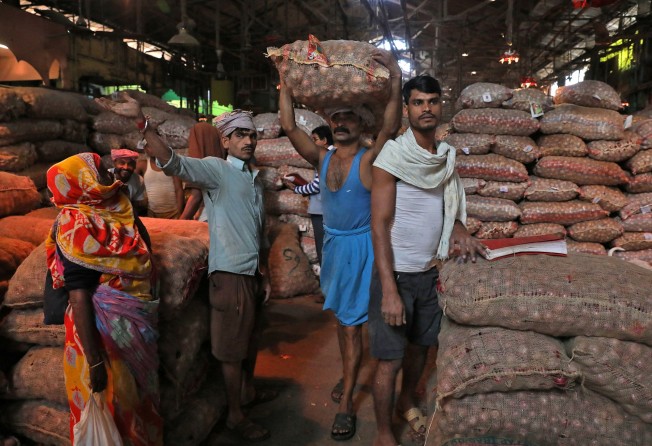
Sri Lanka, India, Pakistan grapple with rising prices as new Omicron variant threatens to sweep South Asia
- Food shortages and a looming economic crisis in Sri Lanka mean only India, China or the IMF can come to its aid
- Pakistan’s opposition parties say people are reeling from ‘back-breaking inflation’ and in New Delhi, watchman Arvind Thakur can no longer afford tomatoes

Inflation is heating up in South Asia, eating into the meagre incomes of the poor and piling pressure on governments just as a new coronavirus wave threatens to sweep the region.
Sri Lanka is reeling from a perfect storm of soaring prices, record money-supply growth and a foreign exchange crisis stemming from the evaporation of tourism revenues because of the pandemic.
Retail inflation jumped to 9.9 per cent in November, a 12-year high, stoked by a 17.5 per cent rise in food prices. As of this month, Sri Lanka had just US$1.6 billion in its foreign exchange reserves, equal to less than one month of imports. The island nation of 22 million people is a net importer of food, with much of its wheat, sugar and milk powder coming from overseas. And with the Sri Lankan rupee down 27 per cent from early 2020, import bills have skyrocketed as well.

The foreign exchange debacle is threatening to plunge the country into default. “The economic situation in Sri Lanka is going from bad to worse, with a surge in inflation undermining the credibility of the central bank and making a debt default all the more likely,” said Gareth Leather, senior emerging markets economist at Capital Economics.
Last month, in the first major protest against Sri Lanka’s strongman president Gotabaya Rajapaksa’s government since it swept to power in November 2019, thousands of demonstrators thronged the capital to vent anger over rising prices and food shortages.
To shore up its foreign reserves, the government has taken a string of draconian steps, declaring a “state of emergency” to control food prices; slapping broad import bans on food, fuel, vehicles and medicines; imposing curbs on imports of mobile phones, clothing and household appliances; and announcing strict controls on foreign currency leaving the country.
In a particularly disastrous move, the government declared in April that Sri Lanka would go organic overnight and stop using chemical fertilisers and pesticides. It claimed the move was to safeguard citizens’ health, but critics said it was to save on imports. Either way, the government rescinded the decision seven months later after farmers blamed the policy for a big drop in crop yields, with tea plantation owners angered by the possible destruction of valuable export crops.
Sri Lanka’s central bank was the first in Asia to increase interest rates amid the pandemic, raising its key rates in August last year by 50 basis points. But since then the bank has held rates steady, fearful of choking growth it projects will reach 5 per cent this year following last year’s 3.6 per cent contraction – despite increased prices.
Analysts say the probability of a debt payment default – the country owes US$6.9 billion in foreign currency debt to be repaid next year and US$26 billion through to 2026 – in the coming months has increased.
Our present problem is how we will survive after the next four weeks
International ratings agency Fitch, which recently downgraded Sri Lanka to a “CC” rating, said the country could draw down on an existing currency swap facility with the People’s Bank of China for up to 10 billion yuan (US$1.57 billion). New Delhi is working on a security package for Sri Lanka covering food, health and energy, as well as a US$400 million currency swap, according to India’s Economic Times.
Separately, The Press Trust of India said Sri Lanka was negotiating with India and Oman to open credit lines for fuel purchases. It has also reached an agreement to settle US$250 million in oil debt it owes Iran using tea exports.
But Fitch said: “even if all these sources are secured, we believe it will be challenging for the government to maintain sufficient external liquidity to allow for uninterrupted debt servicing in 2022.”
Economists say the best way for Sri Lanka to solve its troubles would be to seek a loan from the International Monetary Fund. But that would involve unpopular austerity measures and Rajapaksa has vowed not to go cap-in-hand to the lender.
W.A. Wijewardena, a former deputy governor of Sri Lanka’s central bank, said it may be too late for IMF aid to solve the immediate crisis. “Our present problem is how we will survive after the next four weeks. For that, quick bilateral assistance of adequate size should be obtained either from India or China,” he told a recent economic forum.
“However, it’s still the IMF that’s the most affordable, cheaper and effective option” longer-term, he said.
A regional problem
Shades of Sri Lanka’s current woes can increasingly be seen elsewhere in the region. In India, wholesale prices have accelerated by the fastest pace in three decades, climbing by 14.2 per cent year on year in November. Harvest shortfalls caused by bad weather, higher global commodity prices, persistent supply-chain knots and a sliding rupee have all made imports costlier.
Arvind Thakur, a New Delhi watchman who lost his wife to India’s catastrophic second wave of Covid-19 earlier this year, earns just 12,000 rupees (US$159) a month. He is struggling to stretch his wages to cover food and housing for himself, his four-year-old daughter and widowed mother.
“We’re not buying tomatoes right now because they’re so expensive,” he said.
With polls looming in key electoral battleground states like Uttar Pradesh, Prime Minister Narendra Modi’s ruling Bharatiya Janata Party is wary of the pivotal role of the so-called “onion factor” in undermining governments’ popularity. Prices of onion and tomato have spiked in recent months – and once these staples get too costly for India’s poor, who spend over half their incomes on food, politicians better watch out, so the political wisdom goes.

While India’s retail inflation is 4.9 per cent, still comfortably below the central bank’s 6 per cent cap, economists forecast prices will keep rising over the coming months in the country of nearly 1.4 billion people. But India’s central bank is maintaining what analysts call a “super-dovish” stance, prioritising economic growth over inflation, and keeping the key repo rate – the one it uses to lend to commercial banks – at a record low 4 per cent.
It has projected “world-beating” growth of 9.5 per cent this year, after the economy shrank last year by some 7.3 per cent. But there are worries a potential third wave of Covid-19 could push the recovery off course.
“The economy remains highly exposed to new outbreaks either of Omicron or potential successor [variants],” said Shilan Shah, another senior emerging-markets economist at Capital Economics. New restrictions to contain the virus would also push up inflation, economists say.
In Pakistan, opposition parties say people are struggling with “back-breaking inflation” as the country’s pandemic-battered economy teeters on the brink of crisis. Opposition parties have organised protests nationwide against the steeply rising cost of living – stoked by the currency plunging to record lows, rapid money-supply growth, rising commodity prices and supply bottlenecks.
In the three years since Prime Minister Imran Khan took office promising a “New Pakistan”, the rupee has cratered by more than 70 per cent, including 15 per cent since May. The rupee’s dive has been a disaster for the import-dependent nation of 220 million, sharply reducing its foreign purchasing power while propelling its trade deficit to an all-time peak.
Consumer price inflation jumped 11.5 per cent in November from the previous year, well above the central bank’s 6 per cent target, and economists see prices sticking to an upwards trajectory even with government subsidies on staples. Since 2018, according to the statistics bureau, sugar prices have soared 83 per cent, flour 50 per cent, chicken 60 per cent, beef 50 per cent and edible oils 133 per cent.
To try to cool price rises and arrest the rupee’s fall, the central bank has been aggressively tightening monetary policy, hiking its key interest rate this month by 100 basis points after increasing it by 150 points last month and 25 basis points the month before.
The political fallout from soaring prices, stagnating wages and unemployment – the Pakistan Institute of Development Economics calculates joblessness at 16 per cent compared to the government’s claim of 6.5 per cent – is being felt at the ballot box, with ex-cricketer Khan’s ruling party recently being trounced in local polls in its northwestern of Khyber-Pakhtunkhwa province.
Despite monetary tightening that could curtail growth, the government is still forecasting a 5 per cent expansion for the country of 220 million people. It hopes the economy will stabilise with a US$3-billion loan from Saudi Arabia and a deal with the IMF to revive a US$6 billion funding package. The IMF has said it will unlock a US$1-billion tranche as long as Islamabad increases taxes, including on petrol, and boosts electricity tariffs, steps that will further fuel inflation.